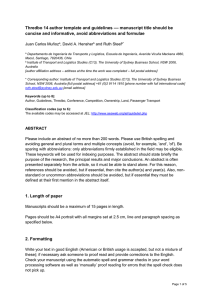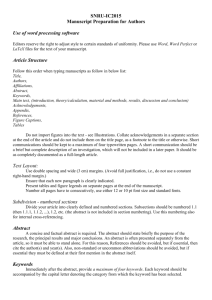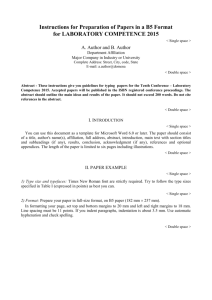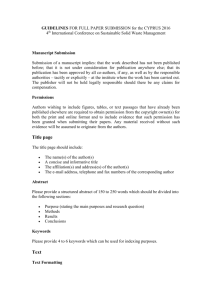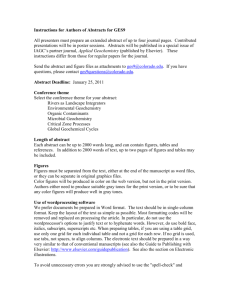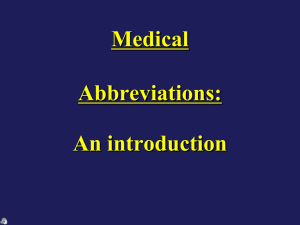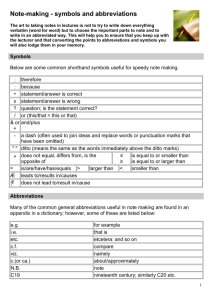Article Template: Research Paper Guidelines
advertisement
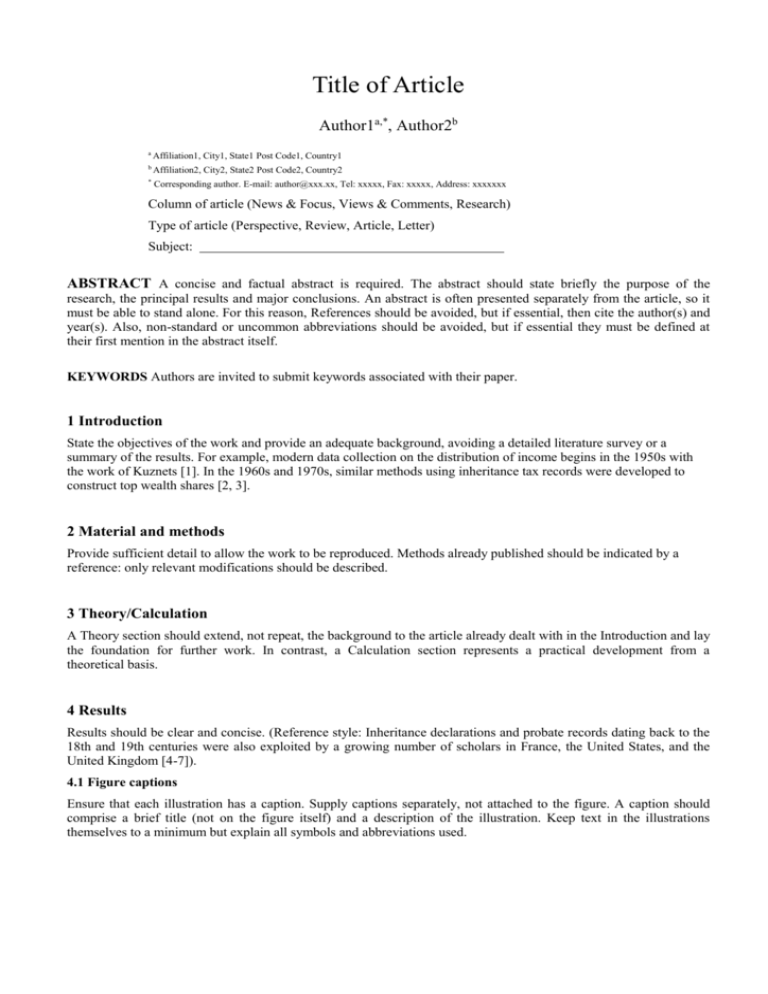
Title of Article Author1a,*, Author2b a Affiliation1, City1, State1 Post Code1, Country1 b Affiliation2, City2, State2 Post Code2, Country2 * Corresponding author. E-mail: author@xxx.xx, Tel: xxxxx, Fax: xxxxx, Address: xxxxxxx Column of article (News & Focus, Views & Comments, Research) Type of article (Perspective, Review, Article, Letter) Subject: ABSTRACT A concise and factual abstract is required. The abstract should state briefly the purpose of the research, the principal results and major conclusions. An abstract is often presented separately from the article, so it must be able to stand alone. For this reason, References should be avoided, but if essential, then cite the author(s) and year(s). Also, non-standard or uncommon abbreviations should be avoided, but if essential they must be defined at their first mention in the abstract itself. KEYWORDS Authors are invited to submit keywords associated with their paper. 1 Introduction State the objectives of the work and provide an adequate background, avoiding a detailed literature survey or a summary of the results. For example, modern data collection on the distribution of income begins in the 1950s with the work of Kuznets [1]. In the 1960s and 1970s, similar methods using inheritance tax records were developed to construct top wealth shares [2, 3]. 2 Material and methods Provide sufficient detail to allow the work to be reproduced. Methods already published should be indicated by a reference: only relevant modifications should be described. 3 Theory/Calculation A Theory section should extend, not repeat, the background to the article already dealt with in the Introduction and lay the foundation for further work. In contrast, a Calculation section represents a practical development from a theoretical basis. 4 Results Results should be clear and concise. (Reference style: Inheritance declarations and probate records dating back to the 18th and 19th centuries were also exploited by a growing number of scholars in France, the United States, and the United Kingdom [4-7]). 4.1 Figure captions Ensure that each illustration has a caption. Supply captions separately, not attached to the figure. A caption should comprise a brief title (not on the figure itself) and a description of the illustration. Keep text in the illustrations themselves to a minimum but explain all symbols and abbreviations used. Figure 1 A caption should comprise a brief title 4.2 Tables Number tables consecutively in accordance with their appearance in the text. Place footnotes to tables below the table body and indicate them with superscript lowercase letters. Avoid vertical rules. Be sparing in the use of tables and ensure that the data presented in tables do not duplicate results described elsewhere in the article. Table 1 Sample table. Column 1 Column 2 Column 3 10% 0.0475 10559 15% 0.0536 13142 20% 0.0587 16395 25% 0.066 17531 30% 0.0684 19208 35% 0.0666 18529 40% 0.0652 17457 4.3 Formulae Formulae should be located separately from other lines and centered with the formula No. bracketed following the formula. Formulae should be typewritten by MathType in Word. It is extremely important that all mathematical symbols and letters used are identified and listed and that the required style of appearance of such symbols is clearly indicated, e.g., boldface, italics, script, outline, superscript, subscript, etc. cm l cmr l jcmi l (1) 5 Discussion This should explore the significance of the results of the work, not repeat them. A combined Results and Discussion section is often appropriate. Avoid extensive citations and discussion of published literature. 6 Conclusions The main conclusions of the study may be presented in a short Conclusions section, which may stand alone or form a subsection of a Discussion or Results and Discussion section. Acknowledgements Collate acknowledgements in a separate section at the end of the article before the references and do not, therefore, include them on the title page, as a footnote to the title or otherwise. List here those individuals who provided help during the research (e.g., providing language help, writing assistance or proof reading the article, etc.). Compliance with ethics guidelines All authors (the name of author) declare that they have no conflict of interest or financial conflicts to disclose. 2 References Reference to a journal publication: 1. B. Hutton. Product of fuzzy topological space. Topol. & Appl., 1980, 11(1): 59-61 2. D. K. Payne, M. D. Sullivan, M. J. Massie. Women’s psychological reactions to breast cancer. Semin. Oncol., 1996, 23(suppl. 2): 89-97 Reference to a book: 3. A. G. Gaydon, H. G. Wolfhard. Flames. 2nd ed. London: Chapman and Hall Ltd., 1960 4. I. J. Norman, S. J. Redfern, eds. Mental Health Care for Elderly People. New York: Churchill Livingstone, 1996 Reference to a chapter in an edited book: 5. V. S. Polito. Calmodulin and calmodulin inhibitors: Effect on pollen germination and tube growth. In: D. L. Mulvshy, E. Ottaviaro, eds. Pollen: Biology and Implication for Plant Breeding. New York: Elsevier, 1983: 53-60 Reference to a proceeding: 6. T. E. Cecil, S. S. Chern. Dupin submanifolds in lie sphere geometry. In: B. J. Jiang, C. K. Peng, Z. X. Hou, et al., eds. Differential Geometry and Topology. Lect Notes in Math, Vol 1369. Berlin: Springer-Verlag, 1989: 1-44 Others: 7. V. Dmtriev. Complete tables of the second rank constitutive tensors for linear homogeneous bianisotropic media described by point magnetic groups of symmetry and some general properties of the media. In: Proceedings of IEEE MTT-S IMOC’99. Berlin: Springer, 2000: 435-439 8. B. Chen. Theoretical studies of dielectronic recombination for Be-like titanium, molybdenum, gold and lead ions and spectrum for highly ionized titanium and gold atoms. Dissertation for the Doctoral Degree. Chengdu: Sichuan University, 1998: 99-100 9. N. A. Phillips. The Nested Grid Model. NOAA Technical Report NWS22, 1979 10. C. J. Plank, E. J. Posinski. US Patent, 4 081 490, 1978-02-15 11. D. L. Wang, J. Zhu, Z. K. Li, et al. User Manual for QTKMapper Version 1.6, 1999 12. Hemodynamics III: The ups and downs of hemodynamics. Version 2.2. Orlando (FL): Computerized Educational Systems, 1993 13. S. C. Anderson, K. B. Poulsen. Anderson’s Electronic Atlas of Hematology. Philadelphia: Lippincott Wilkins, 2002 14. Y. L. Huang. Policy selection and international comparative research on input in higher education in China. Education Accounting Research, 2001(5): 15-22 (in Chinese) 15. Y. L. Xin. Mean curvature flow with convex Gauss image. 2005, arXiv:math.DG/0512380 Note 1 References Citation in text Please ensure that every reference cited in the text is also present in the reference list (and vice versa). Any references cited in the abstract must be given in full. Unpublished results and personal communications are not recommended in the reference list, but may be mentioned in the text. If these references are included in the reference list they should follow the standard reference style of the journal and should include a substitution of the publication date with either “Unpublished results” or “Personal communication” Citation of a reference as “in press” implies that the item has been accepted for publication. Web references As a minimum, the full URL should be given and the date when the reference was last accessed. Any further information, if known (DOI, author names, dates, reference to a source publication, etc.), should also be given. Web references can be listed separately (e.g., after the reference list) under a different heading if desired, or can be included in the reference list. References in a special issue Please ensure that the words ‘this issue’ are added to any references in the list (and any citations in the text) to other articles in the same Special Issue. Reference management software This journal has standard templates available in key reference management packages End Note (http://www.endnote.com/support/enstyles.asp) and Reference Manager (http://refman.com/support/rmstyles.asp). Using plug-ins to word processing packages, authors only need to select the appropriate journal template when preparing their article and the list of references and citations to these will be formatted according to the journal style which is described below. References style 3 The number of the references in the text should be cited in the square brackets (i.e. [ ]). Grouped references should be separated by “,” (two or inconsecutive references) or connected by “-” (no less than three and consecutive references), e.g., [1, 2], [1-5], or [1-3, 5]. Such as: Modern data collection on the distribution of income begins in the 1950s with the work of Kuznets [1]. In the 1960s and 1970s, similar methods using inheritance tax records were developed to construct top wealth shares [2, 3]. Inheritance declarations and probate records dating back to the 18th and 19th centuries were also exploited by a growing number of scholars in France, the United States, and the United Kingdom [4-7]. Journal abbreviations source Journal names should be abbreviated according to Index Medicus journal abbreviations: http://www.nlm.nih.gov/tsd/serials/lji.html; list of title word abbreviations: http://www.issn.org/2-22661-LTWAonline.php; CAS (Chemical Abstracts Service): http://www.cas.org/sent.html. Note 2 Submission checklist The following list will be useful during the final checking of an article prior to sending it to the journal for review. Please consult this Guide for Authors for further details of any item. Ensure that the following items are present: One Author designated as corresponding Author: E-mail address Full postal address Telephone and fax numbers All necessary files have been uploaded: Keywords All figures (accepted format as TIFF or EPS, submit each figure as a separate file) All figure captions All tables (including title, description, footnotes) Further considerations Manuscript has been “spellchecked” and “grammar-checked” References are in the correct format for this journal All references mentioned in the Reference list are cited in the text, and vice versa Permission has been obtained for use of copyrighted material from other sources (including the Web) Color figures are clearly marked as being intended for color reproduction on the Web (free of charge) and in print or to be reproduced in color on the Web (free of charge) and in black-and-white in print If only color on the Web is required, black and white versions of the figures are also supplied for printing purposes Artwork Electronic artwork General points Make sure you use uniform lettering and sizing of your original artwork. Save text in illustrations as “graphics” or enclose the font. Only use the following fonts in your illustrations: Arial, Courier, Times, Symbol. Number the illustrations according to their sequence in the text. Use a logical naming convention for your artwork files. Provide captions to illustrations separately. Produce images near to the desired size of the printed version. Submit each figure as a separate file. Formats 4 Regardless of the application used, when your electronic artwork is finalised, please “save as” or convert the images to one of the following formats (note the resolution requirements for line drawings, halftones, and line/halftone combinations given below): EPS: Vector drawings. Embed the font or save the text as “graphics”. TIFF: color or grayscale photographs (halftones): always use a minimum of 300 dpi. TIFF: Bitmapped line drawings: use a minimum of 1000 dpi. TIFF: Combinations bitmapped line/half-tone (color or grayscale): a minimum of 500 dpi is required. If your electronic artwork is created in a Microsoft Office application (Word, PowerPoint, Excel) then please supply “as is”. Please do not: Supply files that are optimised for screen use (like GIF, BMP, PICT, WPG); the resolution is too low; Supply files that are too low in resolution; Submit graphics that are disproportionately large for the content. Color artwork Please make sure that artwork files are in an acceptable format (TIFF, EPS) and with the correct resolution. Figure captions Ensure that each illustration has a caption. Supply captions separately, not attached to the figure. A caption should comprise a brief title (not on the figure itself) and a description of the illustration. Keep text in the illustrations themselves to a minimum but explain all symbols and abbreviations used. Tables Number tables consecutively in accordance with their appearance in the text. Place footnotes to tables below the table body and indicate them with superscript lowercase letters. Avoid vertical rules. Be sparing in the use of tables and ensure that the data presented in tables do not duplicate results described elsewhere in the article. Note3: Essential title page information Title Concise and informative. Titles are often used in information retrieval systems. Avoid abbreviations and formulae if possible. Author names and affiliations Where the family name may be ambiguous (e.g., a double name), please indicate this clearly. Present the authors’ affiliation addresses (where the actual work was done) below the names. Indicate all affiliations with a lower-case superscript letter immediately after the author’s name and in front of the appropriate address. Provide the full postal address of each affiliation, including the country name, and, if available, the e-mail address of each author. Corresponding author Clearly indicate who will handle correspondence at all stages of refereeing and publication, also post-publication. Ensure that telephone and fax numbers (with country and area code) are provided in addition to the e-mail address and the complete postal address. Contact details must be kept up to date by the corresponding author. Present/permanent address If an author has moved since the work described in the article was done, or was visiting at the time, a “Present address” (or “Permanent address”) may be indicated as a footnote to that author’s name. The address at which the author actually did the work must be retained as the main affiliation address. Superscript Arabic numerals are used for such footnotes. Abstract A concise and factual abstract is required. The abstract should state briefly the purpose of the research, the principal results and major conclusions. An abstract is often presented separately from the article, so it must be able to stand alone. For this reason, References should be avoided, but if essential, then cite the author(s) and year(s). Also, non-standard or uncommon abbreviations should be avoided, but if essential they must be defined at their first mention in the abstract itself. 5 Keywords Authors are invited to submit keywords associated with their paper. Abbreviations Define abbreviations that are not standard in this field in a footnote to be placed on the first page of the article. Such abbreviations that are unavoidable in the abstract must be defined at their first mentions there, as well as in the footnote. Ensure consistency of abbreviations throughout the article. Acknowledgements Collate acknowledgements in a separate section at the end of the article before the references and do not, therefore, include them on the title page, as a footnote to the title or otherwise. List here those individuals who provided help during the research (e.g., providing language help, writing assistance or proof reading the article, etc.). Nomenclature and Units Follow internationally accepted rules and conventions: use the international system of units (SI). If other quantities are mentioned, please give their equivalent in SI. Authors wishing to present a table of nomenclature should do so on the second page of their manuscript. Math Formulae Present simple formulae in the line of normal text where possible and use the solidus (/) instead of a horizontal line for small fractional terms, e.g., X/Y. In principle, variables are to be presented in italics. Powers of e are often more conveniently denoted by exp. Number consecutively any equations that have to be displayed separately from the text (if referred to explicitly in the text). Footnotes Footnotes should be used sparingly. Number them consecutively throughout the article, using superscript Arabic numbers. Many word processors build footnotes into the text, and this feature may be used. Should this not be the case, indicate the position of footnotes in the text and present the footnotes themselves separately at the end of the article. Do not include footnotes in the Reference list. Table footnotes Indicate each footnote in a table with a superscript lowercase letter. 6

